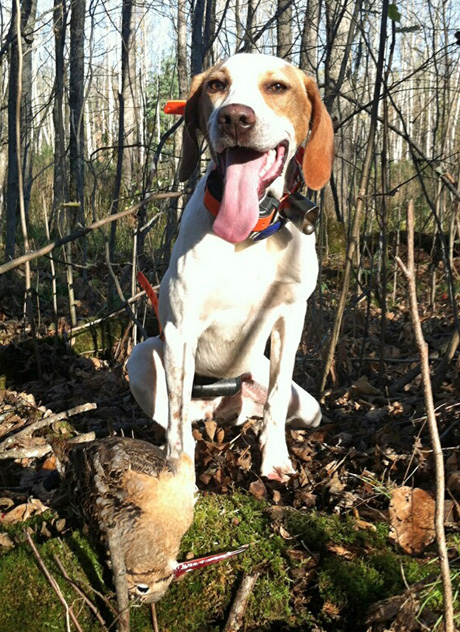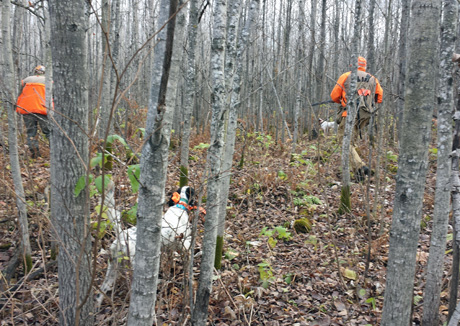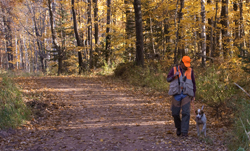How to flush grouse and woodcock

An accurate location by the young pointer Penny (Elhew G Force x Northwoods Vixen, 2013) and a proper flush and good shot by hunter Mike Powers will result in this happy scene.
Flushing grouse and woodcock in front of a pointing dog might seem like a simple concept. It can make the difference, though, between a bird in the bag and an empty shot shell. In more than 20 years of guiding ruffed grouse and woodcock hunters across the northern Great Lakes region, I’ve pretty much seen it all. Some mistakes I attribute to excitement; others are downright comical; and most are merely naïve.
Here are some tips on how to properly flush for grouse and woodcock over a pointing dog.
Grouse or woodcock.
First of all, try to determine which bird is being pointed. Woodcock tend to be closer to the dog while ruffed grouse are usually farther away. Of course, if it’s late in the season and the woodcock have migrated, the bird is a grouse.
Read the dog.
Most dogs will convey bird and bird location by its intensity and body posture. A really intense posture combined with a lowered head and/or body means the bird is right in front and, therefore, likely a woodcock. A dog that stands taller with a higher head and is more relaxed on point indicates the bird is off a distance and likely a grouse. When the dog is twisted due to a sudden point, that means the bird is close and could be either a grouse or woodcock. If a dog is moving its head or looking around or if the tail is ticking, it doesn’t have the bird accurately located.

Two hunters pass the backing dog and move into position to flush for the lead dog in good-looking grouse cover.
Assess the cover.
Look at the vegetation. Young aspen cuts with scattered woodcock splash would be a good indicator for woodcock. On the other hand, a 20-year-old aspen stand with deadfalls and thick, grassy edges is more likely grouse cover. If you’ve found woodcock or grouse in the surrounding cover, that can be a good clue, but not always.
Flush the bird.
Ideally, two hunters should position themselves a few yards on either side of the dog and steadily walk forward in unison, looking for likely places a bird will sit, until about 10 – 15 yards in front of the dog. Be prepared when stopping as this often causes a bird to flush.
If a woodcock is suspected, you can go back and flush more thoroughly in front of the dog. Some woodcock will sit very tight and be difficult to flush.
Also, flush beside or behind the dog. Discern wind direction and flush upwind of the dog. And even if the dog is pointing on one side of a trail, flush on the other side. Finally, look up into the trees.
Be ready for a second bird.
If one bird flushes—whether grouse or woodcock—always be prepared for another flush. If you do shoot, reload immediately. Many times I have watched a hunter shoot both barrels, only to stand with an empty gun while another bird flushes within range.
What not do do.
• Never walk a few feet in front of the dog and stop. The dog isn’t going to flush the bird. Keep walking to flush the bird.
• Never walk up closely beside the dog as this might break its concentration and encourage it to move.




